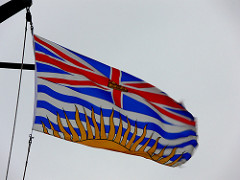I read a story in OHS Magazine Online about a mining safety program in the US.
The Brookwood-Sago grant program is named in memory of 25 miners who died at work in Brookwood, Alabama and at the Sago Mine in Buckhannon, West Virginia.
The grant program announced $1 million will be available for eligible mining companies to help them identify, avoid, and prevent unsafe working conditions. It’s run by the U.S. Department of Labor’s Mine Safety and Health Administration (MSHA).
In 2010, there were 48 fatalities in the US mining industry, down from 1978 when 242 miners died and the MSHA started operating. That’s a big improvement with a long way to go – and I’m hopeful the Brookwood-Sago grants will make a difference.

The BC flag. Photo by Bugman50 on Flickr
Mining safely in BC
Here in BC, no miners died at work in 2010.
The injury rate for miners is the lowest among BC’s heavy industries, reports the Mining Association of BC.
The BC mining industry is governed by a different set of rules. Most BC employers are subject to the Occupational Health and Safety Regulation, but mining companies are not. Instead, they are expected to comply with the Mines Act and The Health, Safety and Reclamation Code, administered by the BC Ministry of Energy and Mines.
Al Hoffman is the Ministry’s Chief Inspector of Mines/Executive Director of Health & Safety. I asked him, via email, what kind of safety training his ministry offered to BC mining companies. He said they offer “mine rescue and musculoskeletal (ergonomics) training, occupational health and safety committee training, and industrial hygiene.”
But legally, it’s up to the mining companies when it comes to safety training, he says.
“The Health Safety and Reclamation Code puts the onus on the mine manager to develop, implement and follow up training programs for all mine employees. The review of these training programs and the maintenance of training records is closely reviewed during our inspection and audit process.”
For more information on mining in BC, check out the 2010 BC Mining Survey, a report by PriceWaterhouseCooper.


